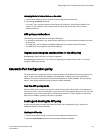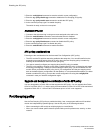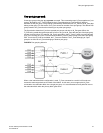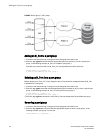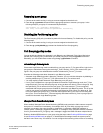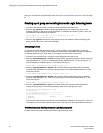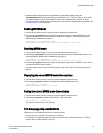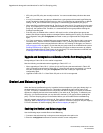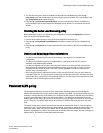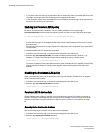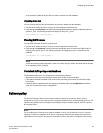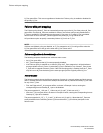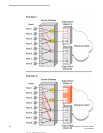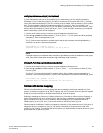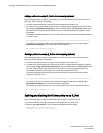3. The Port Grouping policy must be enabled to enable Device Load Balancing. Enter the ag --
policyshow command to determine if the Port Grouping policy is enabled. If it is not enabled, enter
ag --policyenable pg to enable this policy.
4. Enter the ag --policyenable wwnloadbalance command to enable the Device Load Balancing
policy. Because Fibre Channel devices are identified by their WWNs, CLI commands use device
WWNs.
Disabling the Device Load Balancing policy
Before disabling this policy, you should save the configuration using the configUpload command in
case you need this configuration again.
1. Connect to the switch and log in using an account assigned to the admin role.
2. Enter the ag --policydisable wwnloadbalance command to disable the Device Load Balancing
policy.
3. Enter the ag --policyshow command to determine the current status of the Device Load Balancing
policy.
Device Load Balancing policy considerations
• The Device Load Balancing policy should be enabled on the edge AG of a cascaded AG
configuration.
• The Device Load Balancing policy is not applicable on a port group when the APC policy or
Automatic Login Balancing are enabled.
• If a device is mapped to a port that is currently part of a trunk, then the device will use that trunk.
When trunking is used with the Device Load Balancing policy, then the load on each trunk will be
proportional to the number of ports in that trunk. Use the ag -show command to determine the
devices using a particular trunk.
• When using the Device Load Balancing policy, make sure that all ports in the port group have the
same NPIV login limit. If some ports have a lower login limit than the other ports, and there are many
logins to the group, some devices will repeatedly attempt to connect to the device with the lower limit
(because it has the fewest logins) and fail to connect.
Persistent ALPA policy
The Persistent ALPA policy is meant for host systems with operating systems that cannot handle
different PID addresses across login sessions when booting over a SAN. The Persistent ALPA policy for
switches in Access Gateway mode allows you to configure the AG module so that the host is more likely
to get the same PID when it logs out of and into the same F_Port. Because the Arbitrated Port Loop
Address (ALPA) field makes up a portion of the PID, the PID may change across switch or server power
cycles. This policy, if enabled, helps reduce the chances of a different PID being issued for the same
host.
The benefit of this policy is that it ensures that a host has the same ALPA on the F_Ports through the
host power cycle. You can also achieve the same behavior and benefit by setting the same policy in the
main (core) fabric. When this policy is enabled, AG will request the same ALPA from the core fabric.
However, depending on the fabric, this request may be denied. When this occurs, the host is assigned a
different ALPA. The following modes deal with this situation:
Disabling the Device Load Balancing policy
Access Gateway Administrator's Guide 63
53-1003126-02



